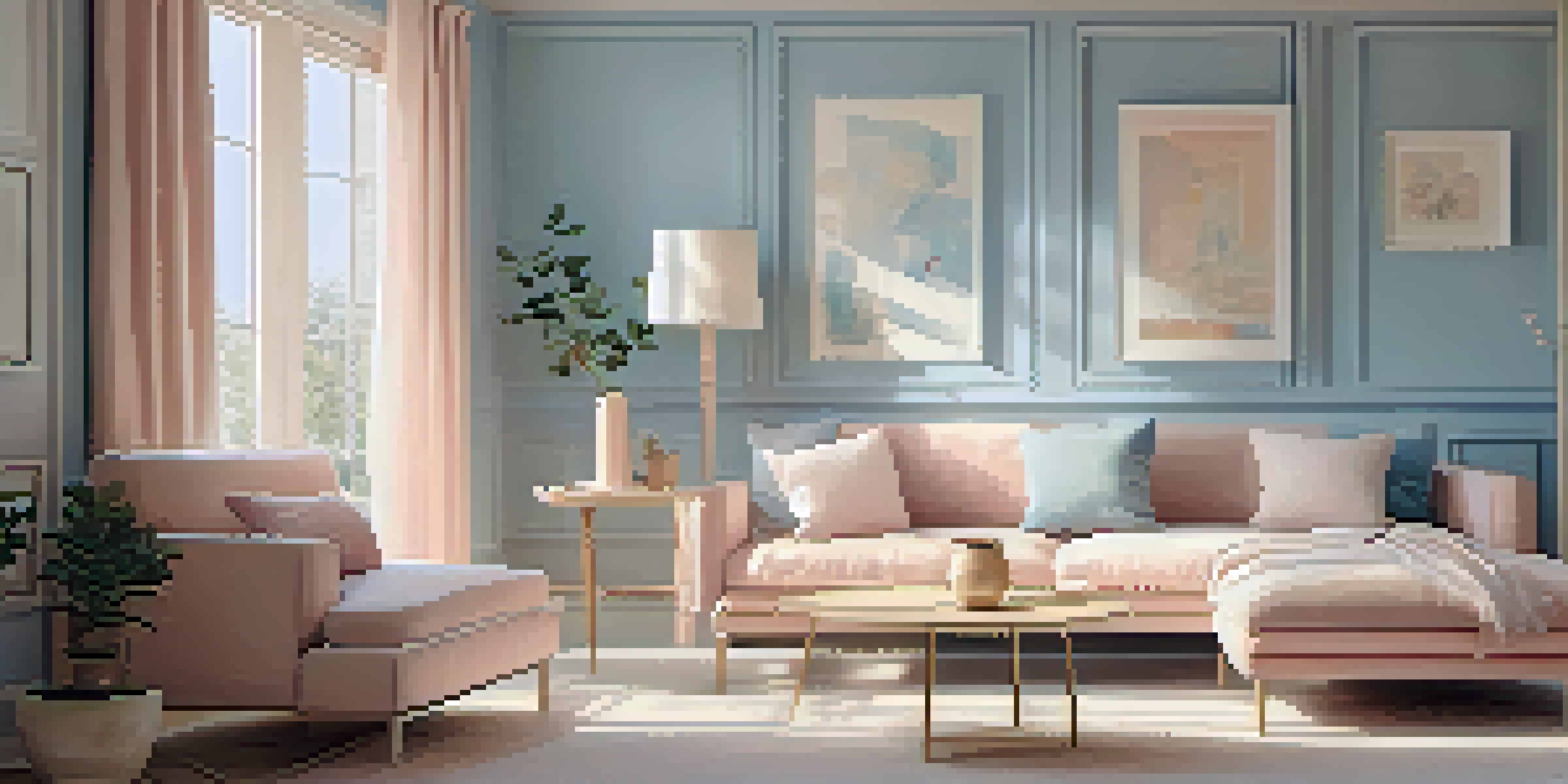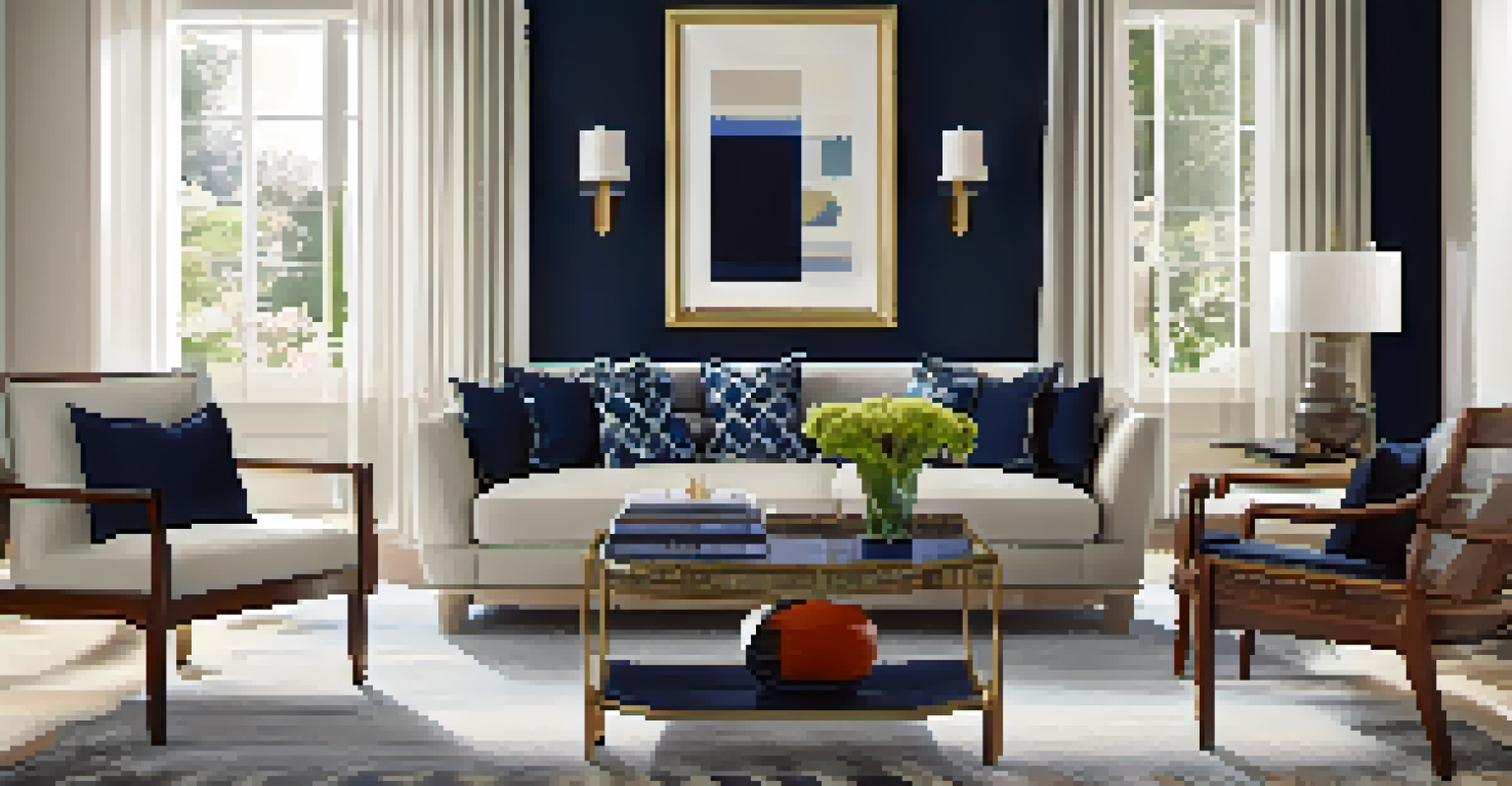Wall Colors That Make Small Rooms Feel Larger

Understanding the Impact of Color on Space Perception
Colors can dramatically influence how we perceive space. Lighter hues tend to reflect more light, creating an illusion of openness. Conversely, darker colors can make a room feel more enclosed and smaller. Understanding this principle is key to selecting the right wall colors for small spaces.
Color is the keyboard, the eyes are the harmonies, the soul is the piano with many strings.
When you enter a room painted in a light shade, such as soft whites or pale pastels, it often feels more expansive. This is because these colors bounce light around the space, preventing it from feeling cramped. A simple shift in color can lead to a refreshing transformation in how we feel in a room.
Consider the psychology behind colors as well. For instance, blue and green tones are often associated with tranquility and nature, which can make a small room feel like a serene retreat. By combining the right color with the right intent, you can enhance the atmosphere of your space.
The Power of Light Colors: Whites and Off-Whites
When it comes to making a small room feel larger, white is your best friend. This classic color reflects light, creating a bright and airy atmosphere. Off-whites, like cream or ivory, can also soften the harshness of pure white, making a room feel cozy yet expansive.

For added warmth, consider using warm whites that can mimic natural light. These tones help to create a welcoming environment without sacrificing the spacious feel. Pairing them with light-colored furnishings can further enhance this effect.
Color Influences Space Perception
Lighter colors create an illusion of openness, while darker shades can make a room feel smaller.
Additionally, using white on walls and ceilings can visually extend the height of the room. When the walls and ceiling blend seamlessly, it tricks the eye into thinking the room is larger than it is. This simple trick can work wonders in tight spaces.
Soft Pastels: A Gentle Way to Open Up Space
Soft pastel colors, like light blue, blush pink, or mint green, are excellent choices for small rooms. These hues bring a sense of calm while still allowing light to bounce around the space. They create a gentle, airy feel that can make even the tiniest rooms feel more inviting and open.
The colors you choose can set the mood of a space and affect how it feels.
Using pastels in a small room can also create a cohesive look. By choosing furnishings and decor in complementary pastel shades, you can maintain a light and harmonious aesthetic. This strategy helps avoid visual clutter, which is essential in smaller spaces.
Moreover, pastel colors can evoke a sense of spaciousness while adding a touch of personality. You can play with different pastel shades to suit your style without overwhelming the space. This makes them a versatile option for anyone looking to enhance their small room.
Cool Tones: Blues and Greens for a Breezy Feel
Cool colors such as light blues and soft greens can work wonders in small rooms. These shades have a calming effect and can create a sense of tranquility and openness. When you choose these colors, you're essentially inviting a breath of fresh air into the space.
Light blue, for instance, can remind us of the sky and water, making a room feel more expansive. Similarly, soft greens can bring elements of nature indoors, enhancing the feeling of space and serenity. Both colors can be used effectively in bedrooms or living areas.
Pastels Enhance Small Rooms
Soft pastel colors provide a calming atmosphere and can make tiny spaces feel more inviting.
Incorporating cool tones doesn’t mean you have to stick to just paint. You can also use accessories, artwork, and textiles in these shades to create a cohesive look while maintaining an airy feel. This layering can add depth without closing in the space.
Neutrals: Beige and Gray for Timeless Elegance
Neutral colors like beige and light gray are excellent for small rooms, providing a sophisticated backdrop that can feel both expansive and cozy. These colors can easily match a variety of decor styles, from modern to traditional, making them a versatile choice.
Beige, for instance, can add warmth while still feeling open and airy. Light gray offers a contemporary vibe that can make a room look chic and stylish. Both colors can be enhanced with pops of color through furniture and decor to keep the space lively.
Additionally, neutrals can create an illusion of depth in a room. By using varying shades of the same neutral color, you can add dimension without overwhelming the senses. This subtle technique helps in maintaining a spacious feel while adding visual interest.
Accent Walls: A Bold Statement Without Clutter
Using an accent wall in a small room can create a focal point without overwhelming the space. By painting just one wall a darker or bolder color, you can add depth and interest without making the entire room feel closed in. The key is to choose a color that complements your lighter walls.
For example, a deep navy blue can add sophistication to a room with white or light gray walls. This contrast draws the eye and can create the illusion of depth, making the room feel more expansive overall. It’s a simple yet effective way to introduce personality without sacrificing space.
Accent Walls Add Depth
A bold accent wall can create a focal point and depth without overwhelming a small room.
Just remember to keep the accent wall consistent with your decor style. This ensures that the room remains cohesive and that the accent wall enhances the overall ambiance. A well-chosen accent wall can elevate a small space into something truly unique.
Finishing Touches: How Decor Complements Color Choices
Choosing the right wall color is just the beginning; decor plays a crucial role in enhancing the feeling of space. Light-colored furniture and accessories can help maintain an airy atmosphere, while darker items can anchor the room. Striking a balance is essential.
Mirrors are an excellent addition to small rooms, reflecting light and creating the illusion of depth. Placing a large mirror opposite a window can amplify natural light, making the space feel even larger. This simple trick can transform the ambiance of any small room.

Lastly, keep your decor minimal to avoid clutter. Selecting a few key pieces that resonate with your style can help maintain a spacious feel. This approach not only makes the room look larger but also creates a serene and inviting environment.